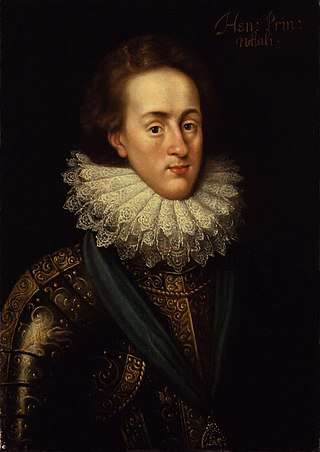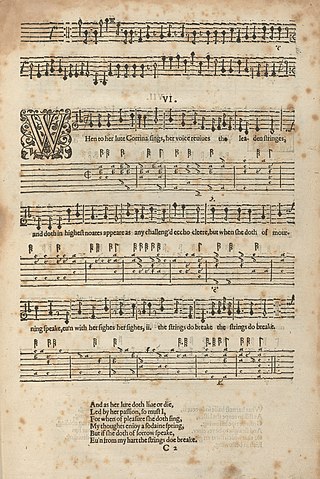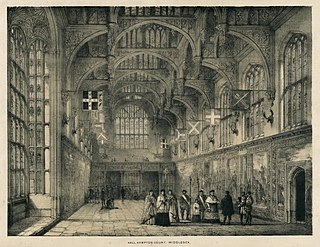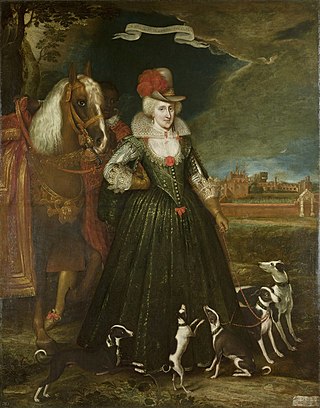Related Research Articles

Lady Arbella Stuart was an English noblewoman who was considered a possible successor to Queen Elizabeth I of England. During the reign of King James VI and I, she married William Seymour, 2nd Duke of Somerset, another claimant to the English throne, in secret. King James imprisoned William Seymour and placed her under house arrest. When she and her husband tried to escape England, she was captured and imprisoned in the Tower of London, where she died at age 39.

Henry Frederick, Prince of Wales,, was the eldest son and heir apparent of James VI and I, King of England and Scotland; and his wife Anne of Denmark. His name derives from his grandfathers: Henry Stuart, Lord Darnley; and Frederick II of Denmark. Prince Henry was widely seen as a bright and promising heir to his father's thrones. However, at the age of 18, he predeceased his father, dying of typhoid fever. His younger brother Charles succeeded him as heir apparent to the English, Irish, and Scottish thrones.

Dunfermline Palace is a ruined former Scottish royal palace and important tourist attraction in Dunfermline, Fife, Scotland. It is currently, along with other buildings of the adjacent Dunfermline Abbey, under the care of Historic Environment Scotland as a scheduled monument.
Alfonso Ferrabosco the younger was an English composer and viol player of Italian descent. He straddles the line between the Renaissance and Baroque eras.

Philip Rosseter was an English composer and musician, as well as a theatrical manager. His family seems to have been from Somerset or Lincolnshire, he may have been employed with the Countess of Sussex by 1596, and he was living in London by 1598. In 1604 Rosseter was appointed a court lutenist for James I of England, a position he held until his death in 1623. Rosseter is best known for A Book of Ayres which was written with Thomas Campion and published in 1601. Some literary critics have held that Campion wrote the poems for Rosseter's songs; however, this seems not to be the case. It is likely that Campion was the author of the book's preface, which criticizes complex counterpoint and "intricate" harmonies that leave the words inaudible. The two men had a close professional and personal relationship; when Campion died in 1620, he had named Rosseter his sole heir.

The Vision of the Twelve Goddesses was an early Jacobean-era masque, written by Samuel Daniel and performed in the Great Hall of Hampton Court Palace on the evening of Sunday, 8 January 1604. One of the earliest of the Stuart Court masques, staged when the new dynasty had been in power less than a year and was closely engaged in peace negotiations with Spain, The Vision of the Twelve Goddesses stood as a precedent and a pattern for the many masques that followed during the next four decades.
Mary Middlemore was a Courtier and Maid of Honour to Anne of Denmark, subject of poems, and treasure hunter.
Elizabeth Roper was a member of the household of Anne of Denmark. She married Robert Mansell, a glass-making entrepreneur and became involved in his business. She was noted for her business activities as a "capitalist" by the historian Alice Clark.
Mary Gargrave was a courtier to Anne of Denmark.
Elizabeth Harcourt, Courtier to Anne of Denmark.
Dorothy Hastings was a courtier to Elizabeth I of England and Anne of Denmark

Anne Sutton (1589–1615) was an English lady-in-waiting who was a companion of Elizabeth Stuart, Queen of Bohemia. She was the daughter of Edward Sutton, 5th Baron Dudley and Theodosia Harington. Sutton was known as "Mrs Anne Dudley" or "Mistress Dudley" although "Sutton" was the family surname. Elizabeth of Bohemia called her "Nan Duddlie".

John Norlie was an English musician at the Scottish royal court.

Prince Henry's Welcome at Winchester was a masque produced by Anne of Denmark and performed in 1603 at Winchester on a day between 11 and 17 October.

The jewels of Anne of Denmark (1574–1619), wife of James VI and I and queen consort of Scotland and England, are known from accounts and inventories, and their depiction in portraits by artists including Paul van Somer. A few pieces survive. Some modern historians prefer the name "Anna" to "Anne", following the spelling of numerous examples of her signature.

Anne Keilway was an English courtier.

The Masque of Indian and China Knights was performed at Hampton Court in Richmond, England on 1 January 1604. The masque was not published, and no text survives. It was described in a letter written by Dudley Carleton. The historian Leeds Barroll prefers the title, Masque of the Orient Knights.

Anne of Denmark (1574–1619) was the wife of James VI and I. She visited Bath, Somerset in the belief that drinking and bathing in mineral waters could improve her health. The warm springs at Bath had been used for medicinal purposes since Roman times. During her progresses to Bath she was entertained at country houses along the way. The court physician Théodore de Mayerne left extensive notes in Latin describing his treatment of Anne of Denmark from 10 April 1612 to her death. Primarily, she was seeking help for gout or dropsy, a swelling of the legs and feet which made walking difficult. Her companion and servant Jean Drummond described an occasion when the queen was unable to set her swollen foot on the ground. During these progresses, Anne of Denmark visited or came near some of the lands and manors included in her jointure lands, including Corston, and was able to promote the image of the Stuart monarchy.

The wedding of Elizabeth Stuart (1596–1662), daughter of James VI and I, and Frederick V of the Palatinate (1596–1632) was celebrated in London in February 1613. There were fireworks, masques, tournaments, and a mock-sea battle or naumachia. Preparations involved the construction of a "Marriage room", a hall adjacent to the 1607 Banqueting House at Whitehall Palace. The events were described in various contemporary pamphlets and letters.
Robert Henlake or Henlocke was an English maker and tuner of musical instruments who worked for Elizabeth I, James VI and I, and Anne of Denmark.
References
- ↑ Matthew Spring, The Lute in Britain: A History of the Instrument and Its Music (Oxford, 2001), p. 103.
- ↑ Jennifer Neville, Dance, Spectacle, and the Body Politick, 1250-1750 (Bloomington, 2008), p. 19.
- ↑ David Lasocki, A Biographical Dictionary of English Court Musicians, 1485-1714, vol. 1 (Routledge, 2018).
- ↑ Martin Wiggins & Catherine Richardson, British Drama 1533-1642: A Catalogue, vol. 2 (Oxford, 2012), pp. 315-6.
- ↑ Andrew Ashbee, Records of English Court Music, 1603-1625, vol. 4 (1991), p. 7.
- ↑ HMC Rutland, 1 (London, 1905), 414.
- ↑ Andrew Ashbee, Records of English Court Music, 1603-1625, vol. 4 (1991), p. 2.
- ↑ Andrew Ashbee, Records of English Court Music, 1603-1625, vol. 4 (1991), p. 74.
- ↑ John Leeds Barroll, 'Inventing the Stuart Masque', David Bevington & Peter Holbrook, Politics of the Stuart Court Masque (Cambridge, 1998), p. 123.
- ↑ Mara Wade, Triumphus Nuptialis Danicus: German Court Culture and Denmark (Wiesbaden, 1996), p. 49.
- ↑ Andrew Ashbee, Records of English Court Music, 1603-1625, vol. 4 (1991), p. 7.
- ↑ Calendar of the Cecil Papers in Hatfield House, 1604, vol. 16 (London, 1933), p. 432: Nadine Akkerman, The Correspondence of Elizabeth Stuart, Queen of Bohemia: 1603-1631, vol. 1 (Oxford, 2015), pp. 58-9.
- ↑ Andrew Ashbee, Records of English Court Music, 1603-1625, vol. 4 (1991), p. 9.
- ↑ Nadine Akkerman, Elizabeth Stuart, Queen of Hearts (Oxford, 2021), pp. 28-9, 38: Nadine Akkerman, The Correspondence of Elizabeth Stuart, Queen of Bohemia: 1603-1631, vol. 1 (Oxford, 2015), p. 6: William Fraser, Memorials of the Montgomeries, vol. 2 (Edinburgh, 1859), p. 248
- ↑ Andrew Ashbee, Records of English Court Music, 1603-1625, vol. 4 (1991), p. 13: Anne Daye, 'Dancing at Court', Sophie Chiari & John Mucciolo, Performances at Court in the Age of Shakespeare (Cambridge, 2019), p. 141.
- ↑ Andrew Ashbee, Records of English Court Music, 1603-1625, vol. 4 (1991), p. 37.
- ↑ Andrew Ashbee, Records of English Court Music, 1603-1625, vol. 4 (1991), pp. 199-200, 206.
- ↑ Original Letters Relating to the Ecclesiastical Affairs of Scotland, vol. 2 (Edinburgh, 1851), p. 355.
- ↑ John S. Brewer, Court of King James, vol. 2 (London, 1839), pp. 137-8: Thomas Birch, Court and Times of James the First, vol. 1 (London, 1848), pp. 339-40.
- ↑ Barbara Ravelhofer, 'Dancing at the Court of Queen Elizabeth', Christa Jansohn, Queen Elizabeth I: Past and Present (Lit Verlag, 2004), p. 109.
- ↑ Jean Howard, Theater of a City: The Places of London Comedy, 1598-1642 (Philadelphia, 2007), p. 204.
- ↑ Anne Barton, Ben Jonson: Dramatist (Cambridge, 1994), p. 302.
- ↑ John Albin, History of the Isle of Wight, p. 652.